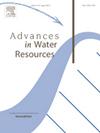Assessment of hybrid RANS/LES models for the prediction of the flow and scour around a wall-mounted cylinder
IF 4
2区 环境科学与生态学
Q1 WATER RESOURCES
引用次数: 0
Abstract
In many environmental flow situations, a solid body emerges from a sediment bed. This may occur in natural systems, for example when a tree-root emerges from the bed, or around a man-made structure such as a bridge pier or a wind turbine foundation. When this situation occurs, various flow-structure interactions such as the horseshoe vortex or vortex shedding lead to the scour process, namely the erosion pattern around the solid obstacle. In this context, accurate numerical prediction of the flow-structure interactions is of primary importance. In this contribution, three-dimensional hydrodynamic simulations are performed using the single-phase incompressible flow solver pimpleFOAM (OpenFOAMv2206plus). Two hybrid RANS-LES turbulence models available in OpenFOAM are tested: the non-zonal SST-SAS model and the zonal SST-IDDES model. As a first benchmark, a plane channel flow configuration at large bulk Reynolds number (1.9 104) is investigated to evaluate the mesh requirements and to determine a set of acceptable numerical parameters. These simulations show that while the SST-IDDES model allows to simulate some features of the fluctuating motions with fewer grid requirements than LES, the SST-SAS model behaves as a RANS model. Concerning the wall-mounted cylinder flow at high Reynolds number (1.8 105), the conclusions are quite different, the SST-SAS model switches to LES in the region of interest namely the horseshoe-vortex region and the wake thanks to its non-zonal property. The SST-SAS model provides better predictions than the SST-IDDES model in terms of amplitude of the bimodal oscillation and vortex merging processes in the horseshoe vortex at lower CPU cost than LES. After this benchmarking and assessment of the hybrid RANS-LES model, a new 2006-SAS turbulence model has been developed for the two-phase flow solver sedFOAM. The model is then applied to a scour configuration around a wall-mounted cylinder and successfully represents the upstream scour depth. The simulations improve the resolution of the complex horseshoe-vortex dynamics which is directly influencing the morphological pattern of the scour process compared with RANS two-phase flow simulations. It also demonstrates interesting mesh convergence properties that RANS does not achieve.
基于混合RANS/LES模型的壁挂式圆柱体流动和冲刷预测评估
在许多环境流动情况下,一个固体从沉积物床中出现。这可能发生在自然系统中,例如,当树根从床上冒出时,或在人造结构(如桥梁桥墩或风力涡轮机基础)周围时。当这种情况发生时,各种流动-结构相互作用,如马蹄形涡或旋涡脱落,导致冲刷过程,即固体障碍物周围的侵蚀模式。在这种情况下,流-结构相互作用的精确数值预测至关重要。在这项贡献中,使用单相不可压缩流动求解器pimpleFOAM (OpenFOAMv2206plus)进行了三维流体动力学模拟。测试了OpenFOAM中可用的两种混合ranss - les湍流模型:非纬向k ωSST-SAS模型和纬向k ωSST-IDDES模型。作为第一个基准,研究了大体积雷诺数(Reb=1.9 × 104)下的平面通道流动配置,以评估网格要求并确定一组可接受的数值参数。这些仿真结果表明,k ωSST-IDDES模型可以模拟波动运动的一些特征,并且比LES模型需要更少的网格,而k ωSST-SAS模型表现为RANS模型。对于高雷诺数壁挂圆柱流动(Reb=1.8 × 105),结论则大不相同,k−ωSST-SAS模型由于其非分区特性,在感兴趣的区域即马蹄形涡区和尾迹区切换为LES。k ωSST-SAS模型在马蹄涡双峰振荡振幅和涡合并过程方面的预测效果优于k ωSST-IDDES模型,且CPU成本低于LES模型。在对混合ranss - les模型进行基准测试和评估之后,为两相流求解器sedFOAM开发了一个新的k−ω2006-SAS湍流模型。然后将该模型应用于壁挂式圆柱体周围的冲刷配置,并成功地表示了上游冲刷深度。与RANS两相流模拟相比,该模拟提高了直接影响冲刷过程形态的复杂马蹄形涡动力学的分辨率。它还展示了有趣的网格收敛特性,这是RANS无法实现的。
本文章由计算机程序翻译,如有差异,请以英文原文为准。
求助全文
约1分钟内获得全文
求助全文
来源期刊

Advances in Water Resources
环境科学-水资源
CiteScore
9.40
自引率
6.40%
发文量
171
审稿时长
36 days
期刊介绍:
Advances in Water Resources provides a forum for the presentation of fundamental scientific advances in the understanding of water resources systems. The scope of Advances in Water Resources includes any combination of theoretical, computational, and experimental approaches used to advance fundamental understanding of surface or subsurface water resources systems or the interaction of these systems with the atmosphere, geosphere, biosphere, and human societies. Manuscripts involving case studies that do not attempt to reach broader conclusions, research on engineering design, applied hydraulics, or water quality and treatment, as well as applications of existing knowledge that do not advance fundamental understanding of hydrological processes, are not appropriate for Advances in Water Resources.
Examples of appropriate topical areas that will be considered include the following:
• Surface and subsurface hydrology
• Hydrometeorology
• Environmental fluid dynamics
• Ecohydrology and ecohydrodynamics
• Multiphase transport phenomena in porous media
• Fluid flow and species transport and reaction processes
 求助内容:
求助内容: 应助结果提醒方式:
应助结果提醒方式:


